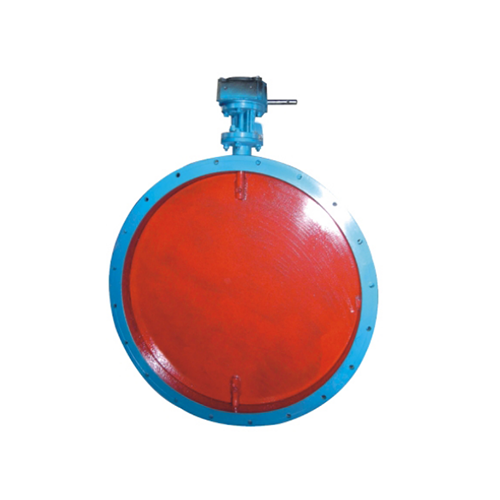This valve is ventilation and dust removal and environmental protection system,the ideal opening and regulating equipment,its unique structure,welding using high quality alloy steel plate,with a small body,light weight,large flow cross section,flexible opening and closing,on-site operation and remote control. Applicable to the metallurgical,mining,building materials,medicine,power plant, chemical industry,light industry and other industries.
Technical data
公称通径DN(mm)Nominal diameter | 100~3000 |
公称压力PN(MPa)Nominal pressure | 0.10 |
电源(电压)Power(voltage) | 三相380V ·AC |
气源气压The air pressure | 0.4-0.6MPa |
泄漏率The leakage rate |
≤1.5% |
适用介质Suitable mediums | 空气、含尘烟气Air,smoke dust |
适用温度C Applicable temperature | ≤300 |
Light ventilation butterfly valve – Complete Guide
The Light Ventilation Butterfly Valve is a compact, lightweight valve designed for airflow control and regulation in ventilation, HVAC, and industrial air handling systems. Combining durable construction with smooth operation, it ensures consistent airflow, minimal pressure drop, and low maintenance requirements.
This guide covers performance testing, installation guidance, application areas, and operation instructions, providing comprehensive information for engineers, facility managers, and industrial buyers seeking reliable and energy-efficient ventilation solutions.
Lightweight Construction: Easy to handle and install, reducing labor costs.
Accurate Airflow Control: Optimized disc design ensures minimal pressure loss.
Durable Materials: Aluminum, stainless steel, or carbon steel construction for corrosion resistance.
Versatile Installation: Suitable for round or rectangular ducts, HVAC systems, and industrial ventilation pipelines.
Low Maintenance: Smooth operation with minimal need for lubrication or adjustment.
Table 1: Product Highlights
| Feature | Benefit |
|---|---|
| Lightweight design | Easy handling and installation |
| Precision disc control | Smooth airflow regulation |
| Corrosion-resistant materials | Long-term durability |
| Versatile duct compatibility | HVAC, industrial ventilation |
| Low maintenance | Reduced operational costs |
Ensuring reliable operation of the Light Ventilation Butterfly Valve involves several performance tests:
Measure airflow rate through the valve at various disc positions.
Ensure pressure drop remains within manufacturer specifications to maintain system efficiency.
Check for air leakage around the disc and seat when fully closed.
Metal or soft seals should provide a tight shut-off, especially for controlled ventilation applications.
Open and close the valve to verify smooth rotation and low operating torque.
Confirm that actuators or manual handles operate without obstruction.
Table 2: Performance Testing Checklist
| Test Type | Purpose | Acceptable Outcome |
|---|---|---|
| Airflow measurement | Verify flow rate | Within system design limits |
| Pressure drop check | Ensure minimal energy loss | ≤ specified pressure drop |
| Leakage test | Confirm tight shut-off | Minimal or no leakage |
| Operational smoothness | Ensure low torque | Smooth, effortless operation |

Correct installation ensures optimal performance and longevity.
Pre-Installation Check: Ensure the duct or pipeline is clean and free of debris.
Positioning: Place the valve between flanges or within the duct, ensuring proper orientation for airflow.
Mounting: Secure with bolts or clamps, making sure the valve body is aligned and not twisted.
Actuator Installation: Attach manual handles, electric, or pneumatic actuators as required.
Initial Operation Test: Open and close the valve fully to ensure smooth movement.
(Note: In the final web or catalog version, include a labeled diagram showing valve placement within a duct, flange connections, and actuator attachment.)
The Light Ventilation Butterfly Valve is suitable for various industries and ventilation systems:
HVAC Systems – Controlling airflow in heating, ventilation, and air conditioning applications.
Industrial Ventilation – Factories, warehouses, and production facilities requiring controlled airflow.
Tunnels and Underground Passages – Ventilation for safety and air quality.
Cleanrooms and Laboratories – Precise airflow regulation to maintain environmental standards.
Agricultural and Food Processing – Ventilation for barns, greenhouses, and processing plants.
Table 3: Typical Application Scenarios
| Application | Key Benefit |
|---|---|
| HVAC systems | Energy-efficient airflow control |
| Industrial ventilation | Improved air quality and safety |
| Tunnels & underground | Emergency ventilation and smoke control |
| Cleanrooms & labs | Precise airflow for contamination control |
| Agricultural facilities | Temperature and humidity regulation |
Proper operation ensures efficient performance and safety:
Rotate the handle or handwheel to adjust the disc position.
Avoid rapid opening or closing to prevent pressure surges in the system.
Confirm fully open and fully closed positions for accurate flow control.
Connect pneumatic or electric actuators according to manufacturer instructions.
Verify that position indicators match the disc location.
Ensure actuators are calibrated for correct torque and stroke limits.
Always wear PPE when installing or operating in industrial environments.
For duct systems with airflow, ensure downstream isolation before servicing the valve.
Avoid operating the valve beyond rated pressure or temperature limits.
Routine maintenance ensures long service life and consistent operation:
Visual Inspection: Monthly, check for corrosion, wear, or leaks.
Operational Test: Quarterly, confirm smooth opening and closing.
Seal Inspection: Every 6 months, check for damage or wear.
Actuator Check: Quarterly, ensure proper functionality.
Apply light lubricant to moving components if needed.
Avoid over-lubrication, which may attract dust or debris.
Use manufacturer-specified replacement discs, seals, and actuators.
Store spare parts in dry, cool conditions to prevent premature degradation.
Table 4: Maintenance Schedule
| Maintenance Task | Frequency | Notes |
|---|---|---|
| Visual inspection | Monthly | Check body, disc, and seals |
| Operational test | Quarterly | Smooth operation check |
| Seal inspection | Every 6 months | Replace if damaged |
| Actuator/function check | Quarterly | Test torque and responsiveness |
| Lubrication | Every 6 months | Use approved lubricant |
The Light Ventilation Butterfly Valve provides efficient, reliable, and low-maintenance airflow control for a wide range of industrial and commercial ventilation systems. Its lightweight construction, durable materials, and precise disc design ensure minimal pressure drop, smooth operation, and long-term performance.
By following proper installation, performance testing, operational guidance, and maintenance schedules, operators can maximize energy efficiency, system reliability, and indoor air quality. Suitable for HVAC, industrial ventilation, tunnels, cleanrooms, and agricultural facilities, this valve is a cost-effective, versatile solution for modern airflow management.
This website uses cookies to ensure you get the best experience on our website.